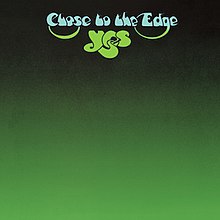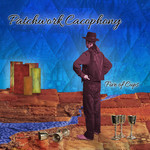1972 – Close To The Edge
The year is 1972, and Yes are being catapulted to new heights by the success of their late 1971 release, Fragile. Does the curse of pressure to produce a follow-up album strike them down? Uh… no.
 Close To The Edge is a masterpiece from start to finish. The title track is a sprawling gem of a composition, starting with bird song and wind and three minutes of instrumental chaos interrupted by block vocals (not a million miles away from the ideas which opened Salisbury, though stylistically and technically it is on a different level). It then breaks into an almost shockingly melodic theme, but the relief doesn’t last long as it starts to get harmonically complex again before the first verse pattern kicks in. All five musicians seem to play different rhythms, with the drums and bass heading in one direction, the vocals in another, and the guitar and keys managing to find even more variations on things to do in between. Rhythmically and generally in terms of complex interplay that manages to hang together, it’s a work of genius.
Close To The Edge is a masterpiece from start to finish. The title track is a sprawling gem of a composition, starting with bird song and wind and three minutes of instrumental chaos interrupted by block vocals (not a million miles away from the ideas which opened Salisbury, though stylistically and technically it is on a different level). It then breaks into an almost shockingly melodic theme, but the relief doesn’t last long as it starts to get harmonically complex again before the first verse pattern kicks in. All five musicians seem to play different rhythms, with the drums and bass heading in one direction, the vocals in another, and the guitar and keys managing to find even more variations on things to do in between. Rhythmically and generally in terms of complex interplay that manages to hang together, it’s a work of genius.
There’s a spacious musical soundscape in the middle with gentle vocals by Anderson and (I’m guessing) Squire and Howe. Again, nothing’s quite straightforward here and rather than harmonising with Anderson, the two second voices sing a second, counter-melodic line which weaves in and out of the main line. A masterful change of rhythm and time signature is introduced between contrasting sections of vocals and cathedral organ before Wakeman elbows his way to the fore with one of his jarring twanging, almost out of tune Moog sounds (but in a good way) and then plays one of those Hammond solos that I seem to forget he’s capable of playing, and then the track comes full circle back through the first verse pattern to the bird song and wind that opened the track.
Throughout the piece (and indeed his career) Jon Anderson’s lyrics are characteristically opaque, but the way he uses them on Close To The Edge shows them more as sounds than actual words, an effect made all the more apparent by the way he ties phrases to specific musical phrases or leitmotifs.
And You And I relaxes the pace and style, with a strongly acoustic feel (somewhat interrupted by the sound of someone playing through something like a Leslie speaker). The piece morphs through a couple of different parts including a somewhat symphonic section but the main impression I’m left with is of the piece is as a ten minute chill out between the two pieces bookending the album. Again, this is no bad thing but it is a track that I feel benefits from its position on the album and which I probably wouldn’t listen to on its own.
The third and final track on the album, Siberian Khatru, is led by Steve Howe’s blistering guitar riff augmented by Wakeman’s odd melltron chords. The rhythm is once again all over the place and there is so much to listen to with no parting being resigned to simple accompaniment of the others.
The album is full of intricate arrangements all the way through and so really rewards repeated listening. The playing is always very tight and there is strong confidence evident in everyone’s playing at all times which is probably necessary in making pieces like this work without sounding like a mess.
I should make special mention of Squire’s playing which really does show why he is so highly rated as a bassist. While he and Bruford certainly manage the usual rhythm section duty of holding things together, Squire also plays his lines very much on an equal level with the keyboard and guitar in the sense of playing an important part in the melodic and harmonic structure of the pieces. In fact, if you put a gun to my head and asked me to pick out a single star of the album, I think it would be Squire.
The album clocks in at what might be seen as a measly 38 minutes, but the amount of ground that they cover in that time makes it feel like a complete album. Playing a little game of “pick the track you’d add to this album,” I don’t think I’d change anything: It’s a five star album as it stands.
Tags: album-of-the-year|Flattr this!
